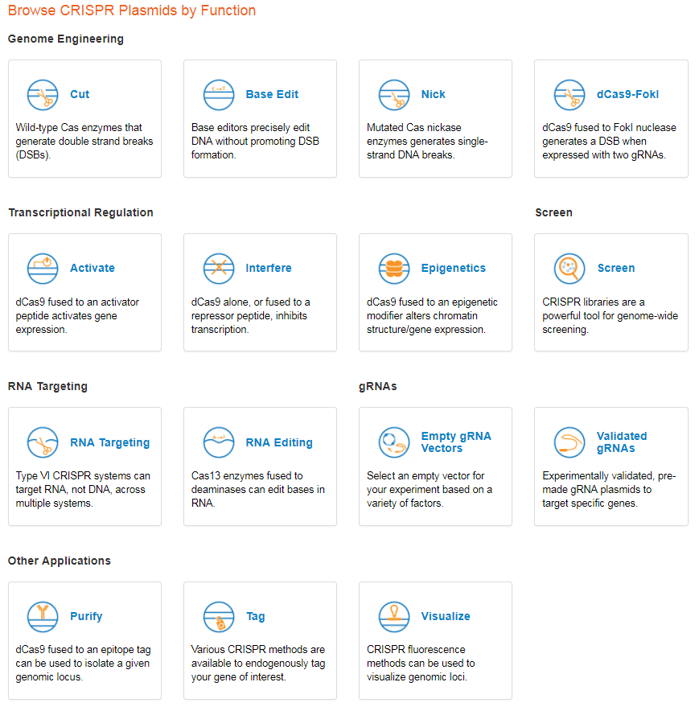Since the start of the CRISPR revolution, Addgene has distributed over 100,000 CRISPR plasmids. But that’s not our only job - we strive to also give you high-quality educational resources to help you do better research. CRISPR is an incredibly fast-moving field, and we want to make it easy for you to keep up with new developments (and, of course, find plasmids that will be useful to you.)
With these goals in mind, we set out to update our web resources and plasmid pages to make them more useful and easy to navigate. We also updated some our most popular CRISPR blogs to keep them current. Here are some of the changes we’ve made:
New CRISPR plasmid pages
We’ve given our CRISPR Plasmids and Resources a fresh new design, sorting the plasmids we have available by category. Each plasmid page now has a helpful graphic to introduce you to the plasmid class covered on that page. To help you find popular plasmids, we’ve also added four new plasmid pages that cover some of the hottest CRISPR tools.

Base Edit: Base editing plasmids allow you to make precise C:G->T:A or A:T->G:C edits in DNA without causing double-strand breaks. Our new page shows you base editing plasmids for mammalian systems, bacteria, plants, and yeast. Popular cytosine base editor pCMV-BE3 has been requested nearly 400 times, and newcomer pCMV-ABE7.10 has already earned a blue flame for its adenine base editing capabilities.
Epigenetics: CRISPR has made it possible to design programmable epigenome editing tools, and the field has certainly taken notice! Our newest page in the Transcriptional Regulation category already has five blue flame plasmids covering three different epigenetic effectors. The diversity of tools is especially exciting, including histone acetylation by p300, histone demethylation by LSD1, cytosine methylation by DNMT3A or MQ1, and cytosine demethylation by Tet1.
RNA Targeting: This page contains Cas13 constructs for mammalian and bacterial systems. Plasmids with wild-type Cas13a (formerly C2c2) can mediate targeted RNA knockdown, which leads to unique non-specific RNA cleavage in bacteria. In mammalian systems, Cas13a degrades only the specified RNA target. Bonus: It displays similar on-target activity to siRNA, but with far fewer off-target effects! This characteristic probably explains why pC016 - LwCas13a guide expression backbone with U6 promoter has already earned a blue flame.
RNA Editing: Did anyone predict that we’d be able to edit RNA in mammalian cells with CRISPR? I certainly didn’t, but now we can with Cas13b/ADAR constructs from the REPAIR (RNA Editing for Programmable A to I Replacement) system. Like RNA targeting systems, RNA editing does not make changes to the genome, thus providing an avenue for temporary/reversible CRISPR modification.
In addition to these subpages, our updated CRISPR Guide and CRISPR History provide a great overview of the development of CRISPR into a varied research toolbox, as well as additional resources to help you Plan Your Experiment.
#12DaysofCRISPR and blog updates
We hope you enjoyed the #12DaysofCRISPR, a celebration of our updated blog resources. Not on social media? No problem - see our recap below!
Day 1: gRNA design tools: How to Design your gRNA for CRISPR Genome Editing and The CRISPR Software Matchmaker
Day 2: Homology directed repair: CRISPR 101: Homology Directed Repair and 3 Tips to Improve HDR Efficiency for CRISPR Editing in Human Cells
Day 3: Cpf1: Cpf1: A New Tool for CRISPR Genome Editing and Multiplex Genome Editing with CRISPR-Cpf1
Day 4: Edit validation: CRISPR 101: Validating Your Genomic Edit and Sequencing Options for CRISPR Genotyping
Day 5: Delivery systems: CRISPR 101: Mammalian Expression Systems and Delivery Methods and A Match Made in Heaven: CRISPR and AAV
Day 6: Bacteria: CRISPR Methods for Bacterial Genome Engineering and CRISPR Antimicrobials
Day 7: Multiplexing and Cas9 variants: CRISPR 101: Multiplex Expression of gRNAs and The PAM Requirement and Expanding CRISPR Beyond SpCas9
Day 8: Repair mechanisms: CRISPR 101: Non-homologous End Joining and PITCHing MMEJ as an Alternative Route for Gene Editing
Day 9: Precision editing: Single Base Editing with CRISPR and Enhancing CRISPR Targeting Specificity with eSpCas9, SpCas9-HF1, & HypaCas9
Day 10: Transcriptional regulation: Truncated gRNAs for Regulating Gene Expression and CRISPR 101: Epigenetics and Editing the Epigenome (plus bonus podcast with Addgene Advisory Board member Alex Chavez)
Day 11: Pooled libraries: Genome-Wide Screening Using CRISPR/Cas9 and Plasmids 101: NGS Quality Control for Pooled Libraries
Day 12: New website resources: CRISPR Plasmids and Resources and CRISPR History and Development for Genome Engineering
Topics: Addgene News, Using Addgene's Website






Leave a Comment